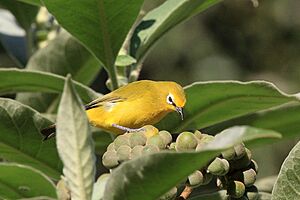Northern yellow white-eye facts for kids
Quick facts for kids Northern yellow white-eye |
|
|---|---|
 |
|
| Kakamega Forest, Kenya | |
| Conservation status | |
| Scientific classification |
The northern yellow white-eye (Zosterops senegalensis) is a small, bright yellow bird. It belongs to the Zosteropidae family, also known as the white-eye family. You can find this bird across a large part of Africa, south of the Sahara Desert. It lives from countries like Senegal in the west to Sudan in the east, and down to northern Angola.
Contents
About the Northern Yellow White-eye
Birds are often grouped into different types called species and subspecies. The northern yellow white-eye used to include some other types of white-eye birds. Scientists later decided to separate these into new species. This happened after a special study in 2013. The new species are the southern yellow white-eye and the green white-eye.
There are seven main groups, or subspecies, of the northern yellow white-eye:
- Z. s. senegalensis – Found from Mauritania and Senegal to northwest Ethiopia.
- Z. s. jacksoni – Lives in west Kenya and north Tanzania.
- Z. s. demeryi – Seen in Sierra Leone, Liberia, and Ivory Coast.
- Z. s. gerhardi – Found in south Sudan and northeast Uganda.
- Z. s. kasaicus – Lives in central D.R. Congo to northeast Angola.
- Z. s. heinrichi – Found in northwest Angola.
- Z. s. quanzae – Lives in central Angola.
What Does the Northern Yellow White-eye Look Like?
This is a small yellow bird. It has a clear white ring around its dark eye. Its body and head are mostly yellow. It has a black stripe near its beak and a black beak. The feathers on its wings and tail are brown. These feathers have yellowish-olive edges. Some types of this bird are greener, especially those living in forests. Young birds are usually darker in color. This bird is about 11.5 centimeters (4.5 inches) long. It weighs between 6.8 and 14.1 grams (0.24 to 0.5 ounces).
Where Do Northern Yellow White-eyes Live?
The northern yellow white-eye lives in many places across sub-Saharan Africa. This area is south of the Sahara Desert. You can find them from countries like Senegal, Gambia, and Mauritania in the west. They live east to Ethiopia and Eritrea. Their home range also goes south to northern Angola.
Northern Yellow White-eye Behavior and Life Cycle
The northern yellow white-eye mainly eats insects. They have been seen eating caterpillars, aphids, and termites. They also eat some fruits, like those from fig trees. They also enjoy nectar from flowers. These birds look for food in the tops of trees. They pick insects off leaves and bark. They often join groups of different bird species to find food together.
Sometimes, another bird called the green-backed honeybird lays its eggs in the northern yellow white-eye's nest. This is a special behavior called brood parasitism. The honeybird's chicks are then raised by the white-eye parents.
The nest of the northern yellow white-eye is shaped like a small cup. It is made from dry grass and small twigs. They build their nests in small trees, about 3.5 meters (11.5 feet) off the ground. They use spider webs to hold the nest together.
The female bird usually lays 2 to 4 eggs. This happens between August and January. Most eggs are laid in September and October. Both parents take turns sitting on the eggs. This is called incubation. It takes about 11 to 12 days for the eggs to hatch. Both parents also help feed the baby birds. The young birds are ready to leave the nest after about two weeks. If something scares the young birds in the nest, they might jump out early.


